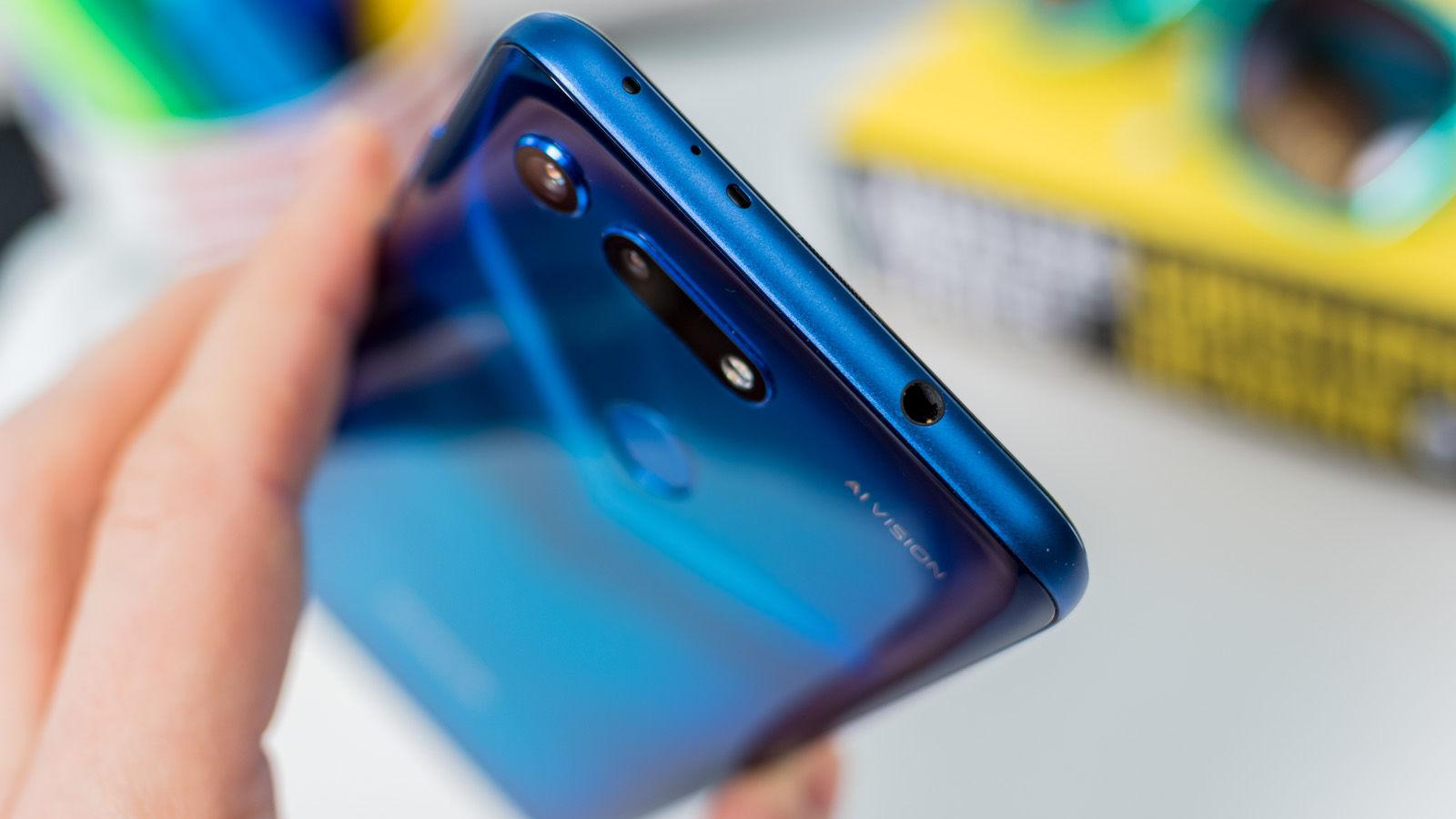Although the phone was released in China in December 2018, Honor showed the View 20 off to western media at CES – where it earned one of Tech Advisor’s Best of CES 2019 awards – it’s now launched the phone in Europe too, at a launch event in Paris.
Price and availability
The View 20 is available in a few colours and versions, starting from £499 for the base model. That comes with 6GB RAM and 128GB storage, and you can get it in either Sapphire Blue or Midnight Black. Our photos show the Phantom Blue version of the phone, which comes with 8GB RAM and 256GB storage and costs £579. In some countries that version is also available in Phantom Red, but unfortunately the UK isn’t getting the red edition of the phone. In the UK the Phantom Blue version of the phone is a Carphone Warehouse exclusive until 9 April. The Honor View 10, its predecessor, launched at £449, so that’s a fairly reasonable increase given that this is a year on. It’s also extremely similar pricing to the OnePlus 6T, which is the phone’s closest rival – also starting at £499 for 6GB/128GB.
Looking un-v-lievable
In all honesty, most of the things that make the View 20 unique come down to its design, rather than its specs, with both the front and rear of the device exciting in their own ways. For the front, you get a punch-hole/pinhole/in-screen camera (take your pick, no-one seems to have decided what to call these yet). The View 20 wasn’t the first phone to be announced with the notch replacement – Samsung got there first with the A8s – but the View 20 is coming out in Europe first, and Honor has been at pains to point out that its camera is a whole 1.5mm smaller, so there’s that. This notch-alternative gives you a close-to full-screen 6.4in display – but in practice it takes up the same amount of screen real estate as the teardrop notches in the likes of the OnePlus 6T, only shifted over to one side and separated slightly from the bezels. Your mileage will vary on whether it’s more or less distracting than a notch, but it’s undeniably striking. If you really hate it, you can always switch it off on the software side and leave a black bar across the top of the display. And so’s the rear of the phone. Honor’s last few flagships have all played around with interesting reflections and refractions, and the View 20 takes this to a whole new level with a nanolithographic design that boasts a subtle V-shape running down the whole back of the phone, without adding any texture to the smooth glass rear. Shift and move the phone around and it catches the light in all sorts of shades and highlights, especially if you opt for one of the coloured versions of the phone. Our review unit is the Phantom Blue version of the phone, but you can also get it in Phantom Red (sadly unavailable in the UK), or Midnight Black and the slightly darker Sapphire Blue – though it’s worth remembering that the Phantom versions of the phone come with slightly higher specs. There’s a fingerprint sensor on the rear – no in-screen fingerprint tech here, even though Honor included it in the Magic 2 – and the USB-C port supports USB 3.1 for faster data transfer, though the included cable is only USB 2.0. Waterproofing is still absent, as is any form of wireless charging. Still, little touches like texturing on the power button to distinguish it from the nearby volume rocker, or the subtle curve to the rear edges, add up to make this feel more polished than any Honor device so far. Basically, this phone looks lush. Honor phones are almost always visually exciting, but the View 20 might just be their prettiest yet, and this is an early contender for 2019’s best designed device. Oh, and you get a headphone jack. Praise the Lord.
Peak performance
Still, looks alone do not a flagship make. Luckily, the View 20 is no slouch when it comes to specs. Inside you’ll find Huawei’s flagship Kirin 980 processor (the same chip as the Mate 20 and Mate 20 Pro), which means this phone breezes through day-to-day tasks and can handle just about any high-end mobile game too. RAM and storage depend slightly on the model you opt for. The regular View 20 comes with 6GB RAM and 128GB storage, while opting for the Phantom versions gets you 8GB and 256GB storage. That means that if you want the higher specs you’ll have to get the phone in blue (or red if you’re in a country with that version), and if you want to save money you’re limited to black and blue.
In our benchmarking the View 20 scored almost identically to the Mate 20 Pro across the board – unsurprising given the internals – and happily trounced last year’s View 10. Up against leading rivals like the Samsung Galaxy S9 and OnePlus 6T the View 20 still holds its own, especially on the Geekbench CPU test and the JetStream browser benchmark – arguably the two with the greatest relevance for ordinary day-to-day usage. Remember that these benchmarks are with the 8GB RAM version of the phone, so performance might be slightly reduced on the 6GB version. The screen is a 6.4in, 2310×1080 panel with a very respectable pixel density of 398ppi. The max screen brightness of 365cd/m2 is a little lower than we’re used to seeing from flagships (a compromise for that in-screen camera perhaps?) but realistically it’s rare that you’ll need to run it up to max anyway. It’s all fine, but from a hardware perspective this is definitely the phone’s weak link – it’s not bad, but it’s not up with there with the big OLED flagships. As for battery life, you’re looking at 4,000mAh, which means this should last most people a couple days of usage. At the time of writing, I’ve been using the phone for two days and two hours and it’s somehow still sitting on 42 percent. It’s not been the most intense weekend of phone usage, but even so I feel confident in saying the battery life should be more than enough for most of you. The View 20 also includes Honor’s ‘supercharging’, though note that it’s just 22W – not the 45W supercharging of the recent Honor Magic 2. Honor says the phone will charge to 55 percent in 30 minutes, and in our testing it actually managed to hit 59 percent in that time – not quite the fastest out then (that goes to the Oppo RX17 Pro) but undeniably nippy. As already noted, there’s no wireless charging here, so it’s wires only we’re afraid. As for software, all of this is running on Android Pie 9.0, with Honor’s Magic UI 2 on top – the company’s slightly tweaked version of Huawei’s EMUI. It’s a little clunky at times, but gives users a decent amount of freedom without sacrificing ease of use too much, and plenty of users find they prefer it to the stock Android experience.
Picture perfect?
Those internal specs are impressive, but what Honor really wants to push is the View 20’s camera setup – on both sides of the phone. Let’s take the front first again. That in-screen camera is packing 25Mp of horsepower, so it’s no slouch, and from using it a bit there’s no evidence that sitting underneath the screen has compromised photo quality at all. I’d hardly consider myself a passionate selfie taker, but it certainly seems to me that anyone who is would be fairly happy with what the View 20 has to offer – obligatory portrait lighting and beauty effects included. The rear cameras are arguably more interesting, punch-hole aside. The twin sensors are each interesting in their own right: one is the first 48Mp sensor anyone has ever bothered to put into a phone camera, while the second is a 3D camera which the phone uses for depth sensing. At this point it’s worth reiterating that megapixels aren’t everything, and this is a case where more definitely doesn’t always equal better – and in fact there can be some disadvantages to super-high pixel counts. Still, under the right conditions this 48Mp sensor should produce some seriously crisp shots, especially with the help of the Kirin 980’s AI image processing in the dedicated Ultra Clarity and Night modes.
Click through our Flickr gallery and you’ll see that landscape and macro shots alike have come out with superb detail and colour reproduction, while even our low light test shot is impressively crisp – and that’s without Honor’s AI mode enabled, which adds extra colour adjustment and post-processing. It tends to make shots look more dramatic and Instagram-ready, but the effect can be a bit overblown. The Ultra Clarity mode here is more interesting. It takes multiple 48MP shots over four seconds or so – meaning you’ll need a steady hand and a still subject – and uses machine learning to combine them into one ur-image. I’ll admit to being a bit sceptical going in, but this crop (below) of our St. Pancras test shots shows just how much work the Ultra Clarity mode is doing. The enhanced shot on the right features crisper text on that street sign, more definition in the brickwork, and better, brighter colour reproduction – and that’s all from a fairly dreary London day. The secondary 3D infrared lens is really more of a gimmick. It should help improve portrait mode, along with a few more niche use cases: artificially slimming you in photos; more accurate calorie counting through the camera by judging portion sizes; and motion-controlled gaming (à la Xbox Kinect, and probably about as well-supported). You can also make little AR characters that will mimic your movements – essentially a full-body version of Animoji. There’s not really much here to show that a 3D camera is any more than a novelty, and we can’t imagine anyone rushing to buy the phone for it. It’s also not accessible in the UK yet, with a software update promised to unlock the functionality – but apparently not for two months or so after launch. But hey, it doesn’t hurt, and the main lens is more than accomplished enough to make up for it anyway.
Verdict
The View 20 is stunning to look at – from just about any angle, thanks to the one-two punch of the pinhole camera on the front and the genuinely unique holographic V effect on the glass rear. The photos look great, but still don’t really do this thing justice – it’s properly gorgeous. The specs are plenty powerful to match, and comfortably rival much more expensive flagship phones (including Huawei’s own Mate 20 Pro). And perhaps for the first time, Honor deserves to be in the same conversation as the big names when it comes to camera quality. Touting a high megapixel count is meaningless, but it’s hard to argue with the results, especially from the AI Ultra Clarity mode. Honor’s flagships have always offered serious specs and slick design while undercutting rivals on price, but it usually feels like there are a couple of compromises along the way. For perhaps the first time, the View 20 doesn’t feel that way. Sure, premium features like wireless charging and waterproofing are still missing, but for most people those remain nice-to-haves – whereas with the core features here Honor is firing on all cylinders.
Related stories for further reading
Best phone deals Best SIM-only deals Best phone network All smartphone reviews Best smartphones How we test smartphones Best new phones coming soon
Tech Advisor’s Deputy Editor, Dom covers everything that runs on electricity, from phones and laptops to wearables, audio, gaming, smart home, and streaming - plus he’s a regular fixture on the Tech Advisor YouTube channel.






